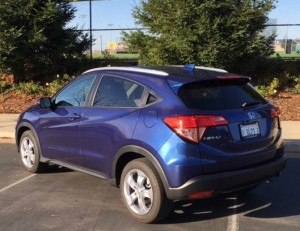Honda decided several years ago that it wanted to be one of the primary players in the subcompact crossover sport utility vehicle class, so it went to work on creating a vehicle that would have mass appeal.
Like most of the vehicles that it manufactures, the all-new 2016 Honda HR-V has immediately earned praise and is off to an impressive start. A check online will reveal that car shoppers like the small SUV for its style, versatility, fuel economy, interior design, and of course its low price – just under $20,000 for the base model.

The subcompact SUV is a growing segment and features a number of strong competitors for the HR-V. Although personally not a huge fan of the Nissan Juke, it is certainly a prominent player in this class. The Mazda CX-3 might be the most comparable to the HR-V. Other notables include the Jeep Renegade, Chevy Trax, and Fiat 500X.
Honda engineers designed the HR-V to be a vehicle that slips into a new category. It’s larger than the Honda Fit, a versatile hatchback, yet smaller than the popular CR-V (a compact SUV). The HR-V is almost as tall and wide as the CR-V, but is nearly 10 inches shorter overall. Both the Fit and the HR-V are manufactured at a Mexican assembly plant.
2016 Honda HR-V
- Performance: 1.8-liter, four-cylinder, 141 horsepower
- Mileage estimate: 25-35 mpg
- Price estimate: $19,215-$25,990
- Warranty: 3 years/36,000 miles; drivetrain: 5 years/60,000 miles; roadside assistance: 3 years/36,000; corrosion: 5 years/unlimited
What enamors car buyers most seems to be the HR-V’s innovative rear seat layout. The “magic seat” is a unique design that is shared by the HR-V and the Fit. The bottom of the seat can easily flip up and accommodate a bike on the floor. When the second row lies flat, it enlarges the cargo space from 24.3 cubic feet to 58.8 cubic feet.
But that’s not the extent of the magic seat’s capability. If only one side of the 60/40 split-folding rear seats is needed, that seat can be folded down and the head rest from the front passenger seat can be removed, creating more space. The front seat can also fold completely backward into the rear seat.
The HR-V is designed to fit five people, yet in reality only two adults will be comfortable in the backseat. The interior is well thought out, featuring a solid design that doesn’t require a lot of thought to master the gadgetry. There are very few hard surface areas and the gauges are sizable and easy to read. A helpful rearview camera is standard.
There is only one engine choice with the front-wheel drive HR-V – a 1.8-liter, four-cylinder that generates 141 horsepower and 127 pound-feet of torque. Although it appears unimpressive and has been tested going a mere 0-60 mph in 9.7 seconds, there were few complaints here with the HR-V’s performance in mostly around town driving and a few trips on the freeway. Note that all-wheel drive is available in some models.
The HR-V provides nice visibility and delivers good ride quality, a trait that most Honda’s possess. It handles turns well and there’s no lack of efficiency when it hits the freeway.
There’s little doubt that the HR-V will become a good seller for Honda. It has many fine characteristics that people seeking a small SUV at a reasonable price will find enticing.